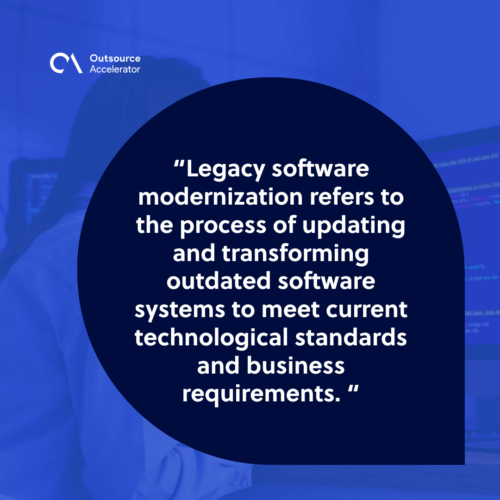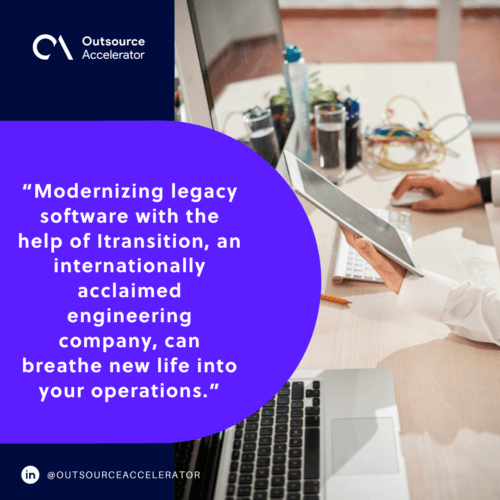5 glaring signs it’s time for a legacy software modernization

Businesses must continually evolve to stay competitive in the digital world.
However, many enterprises find themselves shackled to outdated software systems that were once state-of-the-art but are now hindering progress.
These legacy systems, while familiar and seemingly reliable, often lack the agility and functionality required to meet modern demands. The consequences? Decreased productivity, security vulnerabilities, and missed opportunities for innovation.
Recognizing the telltale signs of an aging software system is crucial for any organization aiming to thrive in the current market.
In this article, we will explore five indications that it’s time for legacy software modernization. We’ll discuss how Itransition can facilitate this critical transformation, ensuring your enterprise not only keeps pace but leads the way in your industry.
What is legacy software modernization?
Legacy software modernization refers to the process of updating and transforming outdated software systems to meet current technological standards and business requirements.
This involves replacing or enhancing old, inefficient, and unsupported systems with modern technologies, architectures, and practices.
The goal of modernization is to improve system performance, security, and scalability while reducing maintenance costs. It aims to enable better integration with new applications and platforms.

Modernization can take various forms, including:
- Rehosting. Moving applications to new hardware or cloud infrastructure without changing the software’s code.
- Replatforming. Adjusting the software to run on modern platforms with minimal changes.
- Refactoring. Restructuring existing code to improve its performance, maintainability, and scalability.
- Rebuilding. Completely redeveloping the application using modern technologies.
- Replacing. Phasing out the old system entirely and implementing a new, more advanced solution.
Legacy software modernization allows organizations to enhance their operational efficiency, improve user experience, and better align their IT infrastructure with business goals.
This transformation also helps in mitigating risks associated with outdated technology, such as security vulnerabilities and compliance issues.
5 telltale signs it’s time for a legacy software modernization
Legacy systems, though familiar, often become more of a burden than a benefit. Recognizing the need for modernization is the first step toward maintaining a competitive edge.
Here are five indications that it’s time to modernize your legacy software:
1. Decreased performance and reliability
Over time, legacy systems tend to slow down and become less reliable. Frequent crashes, long load times, and system outages not only frustrate users but also disrupt business operations.
If your software struggles to handle current workloads or frequently requires costly maintenance, it’s a clear indication that modernization is needed.
2. High maintenance costs
Maintaining legacy software can be expensive, with costs escalating as the system ages. These expenses include not only routine maintenance but also the need for specialized skills to support obsolete technologies.
If you’re spending more on keeping your software running than on innovation and growth, modernization is the way forward.
3. Security vulnerabilities
Older software is more susceptible to cyberattacks due to outdated security protocols and lack of support.
As new threats emerge, legacy systems become prime targets for hackers. If your software isn’t receiving regular security updates and patches, it poses a significant risk to your organization’s data and operations.
4. Integration challenges
Modern businesses rely on a diverse ecosystem of software applications to function seamlessly.
Legacy systems often lack the capability to integrate with new technologies and platforms, creating data silos and workflow inefficiencies.
If integrating your software with other systems is a constant struggle, doing some updates can be the solution.
5. Lack of scalability
As your business grows, your software needs to scale accordingly. Legacy systems often lack the flexibility to adapt to increasing demands or new business models.
If your software can’t support your growth ambitions or requires significant effort to scale, it’s time to invest in a modern solution.
Modernizing legacy software with the help of Itransition, an internationally acclaimed engineering company, can breathe new life into your operations.
With Itransition, you can ensure your technology infrastructure aligns with your business goals and drives sustained success.

Itransition’s legacy software modernization
Itransition specializes in transforming outdated systems into modern, efficient, and scalable solutions tailored to your unique needs. Its comprehensive approach includes everything from rehosting and re-platforming to refactoring and complete rebuilding.
Itransition’s team of well-skilled and experienced IT specialists ensures your software aligns with current technological standards and business goals.
Don’t let outdated software hold you back. Get in touch with Itransition today to learn how it can help modernize your legacy systems and drive your business forward!







 Independent
Independent




